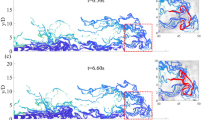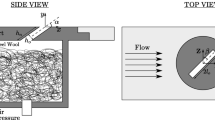Abstract
Vortex behavior and characteristics in a confined rectangular jet with a co-flow were examined using vortex swirling strength as a defining characteristic. On the left side of the jet, the positively (counterclockwise) rotating vortices are dominant, while negatively rotating vortices are dominant on the right side of the jet. The characteristics of vortices, such as population density, average size and strength, and deviation velocity, were calculated and analyzed in both the cross-stream direction and the streamwise direction. In the near-field of the jet, the population density, average size and strength of the dominant direction vortices show high values on both sides of the center stream with a small number of counter-rotating vortices produced in the small wake regions close to jet outlet. As the flow develops, the wake regions disappear, these count-rotating vortices also disappear, and the population of the dominant direction vortices increase and spread in the jet. The mean size and strength of the vortices decrease monotonically with streamwise coordinate. The signs of vortex deviation velocity indicate the vortices transfer low momentum to high-velocity region and high momentum to the low velocity region. The developing trends of these characteristics were also identified by tracing vortices using time-resolved particle image velocimetry data. Both the mean tracked vortex strength and size decrease with increasing downstream distance overall. At the locations of the left peak of turbulent kinetic energy, the two-point spatial cross-correlation of swirling strength with velocity fluctuation and concentration fluctuation were calculated. All the correlation fields contain one positively correlated region and one negatively correlated region although the orientations of the correlation fields varied, due to the flow transitioning from wake, to jet, to channel flow. Finally, linear stochastic estimation was used to calculate conditional structures. The large-scale structures in the velocity field revealed by linear stochastic estimation are spindle-shaped with a titling stream-wise major axis.























Similar content being viewed by others
References
Abramovich G, Girshovich T, Krasheninnikov S, Sekundov A, Smirnova I (1984) The theory of turbulent jets. Moscow Izdatel Nauka
Adrian RJ (1994) Stochastic estimation of conditional structure: a review. Appl Sci Res 53:291–303
Adrian RJ (1999) Uses, analysis and interpretation of piv data. 30th AIAA fluid dynamics conference (c)
Adrian RJ, Christensen KT, Liu ZC (2000a) Analysis and interpretation of instantaneous turbulent velocity fields. Exp Fluids 29:275–290
Adrian RJ, Meinhart CD, Tomkins CD (2000b) Vortex organization in the outer region of the turbulent boundary layer. J Fluid Mech 422:1–54
Agrawal A, Prasad AK (2002a) Organizational modes of large-scale vortices in an axisymmetric turbulent jet. Flow Turbul Combust 68(4):359–377
Agrawal A, Prasad AK (2002b) Properties of vortices in the self-similar turbulent jet. Exp Fluids 33:565–577
Agrawal A, Prasad AK (2003) Measurements within vortex cores in a turbulent jet. J Fluids Eng 125(3):561
Antonia R, Bilger R (2006) An experimental investigation of an axisymmetric jet in a co-flowing air stream. J Fluid Mech 61(04):805–822
Antonia RA, Browne LWB, Rajagopalan S, Chambers AJ (1983) On the organized motion of a turbulent plane jet. J Fluid Mech 134:49–66
Antonia RA, Chambers AJ, Britz D, Browne LWB (1986) Organized structures in a turbulent plane jet: topology and contribution to momentum and heat transport. J Fluid Mech 172:211–229
Benayad S, Salem A, Legrand J (2001) Turbulent mixing in a coflowing liquid jet. Ind Eng Chem Res 40(3):927–932
Bradbury L, Riley J (1967) The spread of a turbulent plane jet issuing into a parallel moving airstream. J Fluid Mech 27(02):381–394
Chhabra S, Huq P, Prasad A (2006) Characteristics of small vortices in a turbulent axisymmetric jet. J Fluids Eng 128:439
Christensen KT, Adrian RJ (2001) Statistical evidence of hairpin vortex packets in wall turbulence. J Fluid Mech 431:433–443
Christensen KT, Adrian RJ (2002a) Measurement of instantaneous eulerian acceleration fields by particle image accelerometry: method and accuracy. Exp Fluids 33(6):759–769
Christensen KT, Adrian RJ (2002b) The velocity and acceleration signatures of small-scale vortices in turbulent channel flow. J Turbul 3:1–28
Chu PCK, Lee JHW, Chu VH (1999) Spreading of turbulent round jet in coflow. J Hydraul Eng 125(February):193
Curtet R (1958) Confined jets and recirculation phenomena with cold air. Combust Flame 2(4):383–411
Deo R, Mi J, Nathan G (2007a) The influence of nozzle aspect ratio on plane jets. Exp Therm Fluid Sci 31(8):825–838
Deo R, Nathan G, Mi J (2007b) Comparison of turbulent jets issuing from rectangular nozzles with and without sidewalls. Exp Therm Fluid Sci 32(2):596–606
Enjalbert N, Galley D, Pierrot L (2009) An entrainment model for the turbulent jet in a coflow. C R Méc 337(9–10):639–644
Feng H, Olsen MG, Liu Y, Fox RO, Hill JC (2005) Investigation of turbulent mixing in a confined planar-jet reactor. AIChE J 51(10):2649–2664
Feng H, Olsen MG, Fox RO, Hill JC (2007a) Conditional statistics for passive-scalar mixing in a confined rectangular turbulent jet. Phys Fluids 19, art. no. 055104
Feng H, Olsen MG, Hill JC, Fox RO (2007b) Simultaneous velocity and concentration field measurements of passive-scalar mixing in a confined rectangular jet. Exp Fluids 42:847–862
Gazzah MH (2010) The dynamic field in turbulent round jet discharging into a co-flowing stream. Nat Sci 02(06):635–640
Goldschmidt V, Bradshaw P (1973) Flapping of a plane jet. Phys Fluids 16:354
Goldschmidt V, Young M, Ott E (1981) Turbulent convective velocities (broadband and wavenumber dependent) in a plane jet. J Fluid Mech 105:327–345
Gordeyev S, Thomas F (2000) Coherent structure in the turbulent planar jet. Part 1. Extraction of proper orthogonal decomposition eigenmodes and their self-similarity. J Fluid Mech 414:145–194
Grinstein F (2001) Vortex dynamics and entrainment in rectangular free jets. J Fluid Mech 437:69–101
Gutmark E, Wygnanski I (1976) The planar turbulent jet. J Fluid Mech 73(03):465–495
Gutmark EJ, Grinstein FF (1999) Flow control with noncircular jets. Annu Rev Fluid Mech 31(1):239–272
Lu Y, Dixon AG, Moser WR, Ma YH (1997) Analysis and optimization of cross-flow reactors with staged feed policies isothermal operation with parallel-series, irreversible reaction systems. Chem Eng Sci 52:1349–1363
Mumford JC (1982) The structure of the large eddies in fully developed turbulent shear flows. Part 1. The plane jet. J Fluid Mech 118:241–268
Nickels T, Perry A (1996) An experimental and theoretical study of the turbulent coflowing jet. J Fluid Mech 309:157–182
Oler J, Goldschmidt V (1982) A vortex-street model of the flow in the similarity region of a two-dimensional free turbulent jet. J Fluid Mech 123:523–535
Olsen MG, Dutton JC (2002) Stochastic estimation of large structures in an incompressible mixing layer. AIAA J 40(12):2431–2438
Olsen MG, Dutton JC (2003) Planar velocity measurements in a weakly compressible mixing layer. J Fluid Mech 486:51–77
Piomelli U, Yu Y, Adrian RJ (1996) Subgrid-scale energy transfer and near-wall turbulence structure. Phys Fluids 8:215–224
Pope S (2000) Turbulent flows. Cambridge University Press, Cambridge
Prasad AK, Adrian RJ, Landreth CC, Offutt PW (1992) Effect of resolution on the speed and accuracy of particle image velocimetry interrogation. Exp Fluids 13:105–116
Robinson SK (1991) Coherent motions in the turbulent boundary layer. Annu Rev Fluid Mech 23
Sadri RM, Floryan JM (2002) Accurate evaluation of the loss coefficient and the entrance length of the inlet region of a channel. J Fluids Eng 124(3):685–694
Steward F, Guruz A (1977) Aerodynamics of a confined jet with variable density. Combust Sci Technol 16(1):29–45
Thomas F, Brehob E (1986) An investigation of large-scale structure in the similarity region of a two-dimensional turbulent jet. Phys Fluids 29:1788
Tomkins CD, Adrian RJ (2003) Spanwise structure and scale growth in turbulent boundary layers. J Fluid Mech 490:37–74
Vollmers H (2001) Detection of vortices and quantitative evaluation of their main parameters from experiment velocity data. Meas Sci Tech 12:1199–1207
Westerweel J, Hofmann T, Fukushima C, Hunt J (2002) The turbulent/non-turbulent interface at the outer boundary of a self-similar turbulent jet. Exp Fluids 33(6):873–878
Westerweel J, Fukushima C, Pedersen J, Hunt J (2005) Mechanics of the turbulent-nonturbulent interface of a jet. Phys Rev Lett 95(17):174,501
Wu Y, Christensen KT (2006) Population trends of spanwise vortices in wall turbulence. J Fluid Mech 568:55–76
Acknowledgments
This work was supported by the National Science Foundation through Grants CTS-9985678 and CTS-0336435.
Author information
Authors and Affiliations
Corresponding author
Rights and permissions
About this article
Cite this article
Kong, B., Olsen, M.G., Fox, R.O. et al. Population, characteristics and kinematics of vortices in a confined rectangular jet with a co-flow. Exp Fluids 50, 1473–1493 (2011). https://doi.org/10.1007/s00348-010-0995-9
Received:
Revised:
Accepted:
Published:
Issue Date:
DOI: https://doi.org/10.1007/s00348-010-0995-9




